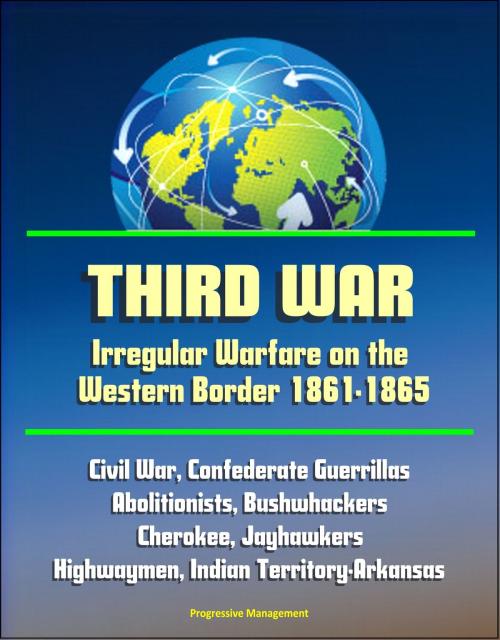Third War: Irregular Warfare on the Western Border 1861-1865 - Civil War, Confederate Guerrillas, Abolitionists, Bushwhackers, Cherokee, Jayhawkers, Highwaymen, Indian Territory-Arkansas
Nonfiction, History, Americas| Author: | Progressive Management | ISBN: | 9781310871139 |
| Publisher: | Progressive Management | Publication: | April 8, 2014 |
| Imprint: | Smashwords Edition | Language: | English |
| Author: | Progressive Management |
| ISBN: | 9781310871139 |
| Publisher: | Progressive Management |
| Publication: | April 8, 2014 |
| Imprint: | Smashwords Edition |
| Language: | English |
Least understood of the effects of the Civil War, and least studied, is the personal war conducted in the Border States, where the North met the South. The number of titles written on this irregular warfare is dwarfed in the literature of the Civil War, with most of the early volumes being markedly partisan. Most of these focused on the violence at the Kansas and Missouri border which, while the most deadly, was by no means the only irregular violence along a border. Every state on the western border, from the gulf coast of Texas to the hills of Appalachia in Kentucky, was consumed by a violence that filled every street and town. This violence was not the type found on the battlefield at Gettysburg, where hoards of men in blue or gray shot at each other from considerable distance, finally moving to close quarters combat. This was a war that flowed into every barnyard or town square, pitting men with strong beliefs supporting one side against individuals they believed to be their enemy. One historian pointed out that "guerrilla war normally arises in impassioned circumstances" and the irregular war in the American Civil War was no exception.
The hatreds and feuds that stayed below the surface in a civilized society were freed by the all-consuming violence of this war, allowing men to act in ways that would have been unacceptable at any other time. While the Union officials, notably Henry Halleck, tried to establish rules of war to control this personal violence, they were markedly unsuccessful. Union authorities attempted to use these rules to combat the southern irregulars, but often chose to abide by them only selectively themselves. Murder, arson, and robbery became common occurrences along the border and the only excuse necessary for such actions was a suspicion that the victim supported the wrong side. Men who had lived as neighbors for many years, some even related to one another, now took up a cause that made them violent enemies.
The border war would eventually degrade to such a level that death was not enough punishment for supporting the wrong side. Both sides would turn to dismemberment and mutilation as expressions of the total loss of control in border society. Actions previously reserved to savages and uncivilized people would now become common as a part of the border violence. This breakdown in society may be a major reason this part of the war has been given inadequate attention over the years. Many historians of the American Civil War have avoided this dirty, ugly war; preferring to continue the glorification of its heroes and grand battles. They, like the Union officers in this study, can't bring themselves to lend legitimacy to the irregular warriors of the border. Through the Second World War, combat was for the most part still a relatively conventional event, with the rules being followed by the belligerents under a common agreement. Since that time, more and more conflicts throughout the world have been fought unconventionally, with the rules of war either watered down or totally ignored. The more common occurrence of this type of conflict has given it more credibility as a viable form of warfare and, as a consequence, sparked a growth in the study of irregular warfare through history. While the reality is that larger military nations continue to question the validity of this type of warfare, it has become commonplace in the modern world and has to be understood.
Topics and subjects covered include: Civil War, Confederate Guerrillas, Indian Territory, jayhawkers, abolitionists, border ruffians, bushwhackers, cherokee, highwaymen, martial law.
Least understood of the effects of the Civil War, and least studied, is the personal war conducted in the Border States, where the North met the South. The number of titles written on this irregular warfare is dwarfed in the literature of the Civil War, with most of the early volumes being markedly partisan. Most of these focused on the violence at the Kansas and Missouri border which, while the most deadly, was by no means the only irregular violence along a border. Every state on the western border, from the gulf coast of Texas to the hills of Appalachia in Kentucky, was consumed by a violence that filled every street and town. This violence was not the type found on the battlefield at Gettysburg, where hoards of men in blue or gray shot at each other from considerable distance, finally moving to close quarters combat. This was a war that flowed into every barnyard or town square, pitting men with strong beliefs supporting one side against individuals they believed to be their enemy. One historian pointed out that "guerrilla war normally arises in impassioned circumstances" and the irregular war in the American Civil War was no exception.
The hatreds and feuds that stayed below the surface in a civilized society were freed by the all-consuming violence of this war, allowing men to act in ways that would have been unacceptable at any other time. While the Union officials, notably Henry Halleck, tried to establish rules of war to control this personal violence, they were markedly unsuccessful. Union authorities attempted to use these rules to combat the southern irregulars, but often chose to abide by them only selectively themselves. Murder, arson, and robbery became common occurrences along the border and the only excuse necessary for such actions was a suspicion that the victim supported the wrong side. Men who had lived as neighbors for many years, some even related to one another, now took up a cause that made them violent enemies.
The border war would eventually degrade to such a level that death was not enough punishment for supporting the wrong side. Both sides would turn to dismemberment and mutilation as expressions of the total loss of control in border society. Actions previously reserved to savages and uncivilized people would now become common as a part of the border violence. This breakdown in society may be a major reason this part of the war has been given inadequate attention over the years. Many historians of the American Civil War have avoided this dirty, ugly war; preferring to continue the glorification of its heroes and grand battles. They, like the Union officers in this study, can't bring themselves to lend legitimacy to the irregular warriors of the border. Through the Second World War, combat was for the most part still a relatively conventional event, with the rules being followed by the belligerents under a common agreement. Since that time, more and more conflicts throughout the world have been fought unconventionally, with the rules of war either watered down or totally ignored. The more common occurrence of this type of conflict has given it more credibility as a viable form of warfare and, as a consequence, sparked a growth in the study of irregular warfare through history. While the reality is that larger military nations continue to question the validity of this type of warfare, it has become commonplace in the modern world and has to be understood.
Topics and subjects covered include: Civil War, Confederate Guerrillas, Indian Territory, jayhawkers, abolitionists, border ruffians, bushwhackers, cherokee, highwaymen, martial law.















